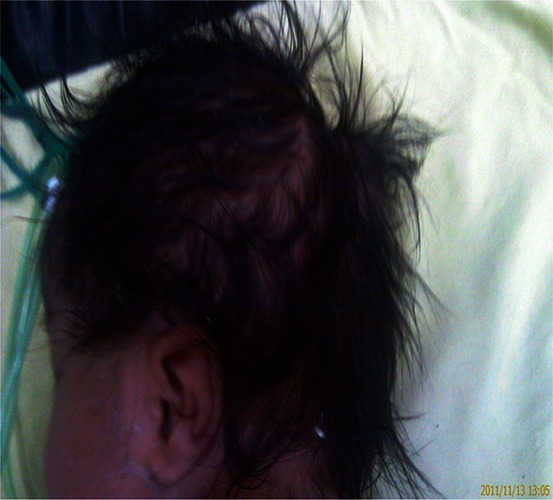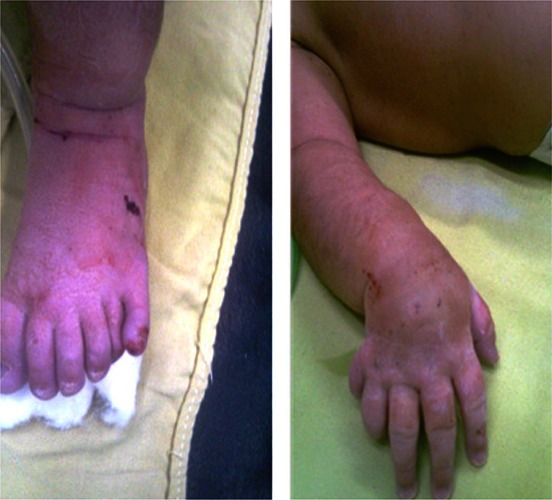Abstract
Meckel-Gruber syndrome is a rare and lethal autosomal recessive disorder characterized by occipital encephalocele, postaxial polydactyly and bilateral dysplastic cystic kidneys. It can be associated with many other conditions. Antenatal ultrasound examination establishes the diagnosis by identifying at least two of the major features described. We describe a female baby who had the typical triad of Meckel-Gruber syndrome and died shortly after birth.
Keywords: Meckel-Gruber syndrome, anomaly, child, Sudan
Introduction
Meckel-Gruber syndrome (MGS) is a rare, lethal autosomal recessive condition mapped to 6 different loci in different chromosomes 17q21–24 (MKS1), 11q13 (MKS2), 8q21.3-q22.1 (MKS3), [1] 12q21.31-q21.33 (MKS4), [2] 16q12.2 (MKS5), [3] and 4p15.3 (MKS6).[4]. This mapping suggests genetic heterogeneity in Meckel-Gruber syndrome. More than 200 cases have been reported.
Meckel-Gruber syndrome is a condition that belongs to the ciliopathies, a category of diseases thought to be caused by dysfunction of cilia and flagella. Polycystic liver and kidney disease, Bardet-Biedl syndrome, Alstrom syndrome, and Joubert syndrome also belong to the same group [5].
The pathophysiology of MGS is complex, One study screened patients with Meckel syndrome for mutations in B9D1 and B9D2 and identified homozygous c.301A>C (p.Ser101Arg) B9D2 mutation. The data showed that the domain-containing proteins Mks1, B9d1, and B9d2 interact physically; the p.Ser101Arg mutation abrogates the ability of B9d2 to interact with Mks1, which suggests that this mutation compromised B9d2 function. The data further showed that B9d1 is required for normal Hedgehog (Hh) signaling, ciliogenesis, and ciliary protein localization. B9d1 and B9d2 are essential components of a B9 protein complex and, when this is disrupted, Meckel syndrome results [6].
The triad of occipital encephalocele, large polycystic kidneys, and postaxial polydactyly characterizes Meckel-Gruber syndrome. Cystic dysplasia of the kidneys is the most constant and characteristic feature of Meckel-Gruber syndrome. Associated abnormalities include oral clefting, genital anomalies; CNS malformations, including Dandy-Walker, Arnold-Chiari malformation, and liver fibrosis. Cardiac lesions like atrial septal defect, coarctation of the aorta and pulmonary stenosis may be present [7,8]. Worldwide, the incidence of Meckel-Gruber syndrome is 1 per 13,250–140,000 live births. Individuals of Finnish descent have a higher incidence (1 per 9000 live births, one person in 50 is a carrier). The incidence is also higher among Belgians and Bedouins in Kuwait, with 1 affected birth in 3,500 (carrier rate 1 in 30). The highest incidence is reported in the Gujarati Indians, with 1 affected birth per 1,300 (carrier rate, 1 in 18) [9].
Prenatal ultrasound is currently the best method available to diagnose Meckel-Gruber syndrome and is available in 2-dimensional (2D), 3-dimensional (3D), and 4-dimensional (4D) modalities. The latter is particularly useful in assessing facial features and deformities, musculoskeletal malformations, and limitation of movement. MRI is a valuable complement to ultrasonography in assessing fetal anomalies in the presence of severe oligohydramnios. It is mainly used when ultrasonography findings are inconclusive or are insufficient to guide treatment choices [10].
Chromosome analysis is essential to exclude trisomy 13, which mimics Meckel-Gruber syndrome. Trisomy 13 carries a 1% recurrence risk, as opposed to the 25% recurrence rate for Meckel-Gruber syndrome. Linkage or mutation analysis is not yet available. The mortality is 100% and most babies die in utero or shortly after birth. Pulmonary hypoplasia is the leading cause of death. Other causes include liver and renal failure [11].
We report a Sudanese female baby with a typical triad of Meckel-Gruber syndrome in whom the diagnosis was not made antenatally but immediately after birth, she died on day three of life. To our knowledge this is the first case report of Meckel-Gruber syndrome from Sudan.
Case Report
A female Sudanese baby born at term by emergency Caesarian section due to failure of progress, she was born with low Apgar score requiring admission to the neonatal unit because of respiratory distress and multiple congenital anomalies. A routine U/S during the 2nd trimester showed hydrocephalus, occipital encephalocele, bilateral hydronephrosis and cleft lip and palate. Folic acid was started during the 2nd trimester. The parents are first degree relatives with no family history of similar condition and no history of miscarriage or stillbirth.
Examination of the baby revealed a sick baby with respiratory distress (RR 80/min), weight was 4Kg, head circumference was 38 cm. There was occipital encephalocele (figure 1). Unilateral complete cleft lip and palate, low set ears and hypertelorism. Also there was post axial polydactyly in both hands and feet (figure 2). The rest of the examination revealed bimanually palpable kidneys, normal female genitalia, normal back and patent anus.
Figure 1.

The occipital encephalocele.
Figure 2.

shows postaxial polydactyly in both hands and feet.
Routine investigations were normal including CBC, renal and liver function tests. Cranial U/S showed dilated ventricles and abdominal U/S showed findings consistent with infantile polycystic kidneys and normal liver. Of note, chromosomal analysis and DNA studies were not available. Based on the above a clinical diagnosis of Meckel-Gruber syndrome was made and the parents were fully counseled regarding the grave prognosis of this condition and the risk of recurrence.
Management of the baby involved oxygen administration, intravenous fluid fluids and antibiotics. The baby remained sick and distressed and on day three developed convulsions requiring phenobarbitone, phenytoin and calcium supplements, after which she developed a prolonged apnoea and died on the same day.
Discussion
The first reports of Meckel-Gruber syndrome (MKS) was published in 1822 by Johann Friedrich Meckel. G.B. Gruber also published reports of patients with Meckel-Gruber syndrome in 1934 and gave it the name dysencephalia splanchnocystica. Meckel-Gruber syndrome is also known as Meckel syndrome and Gruber syndrome [12,13].
Our case had the typical triad of occipital encephalocele, polycystic kidneys and polydactyly and the diagnosis was made after birth. Unfortunately, karyotyping and DNA studies were not available for our patient. Autopsy was strongly rejected by the parents. Autopsy provides valuable information that aids in diagnosis and genetic counseling for future pregnancies. Karyotyping is essential to rule out trisomy 13 which has many features in common with Meckel-Gruber syndrome. Antenatal diagnosis of MGS is possible and is important from counseling point of view. In our case there was antenatal diagnosis of multiple congenital anomalies but not specific of Meckel-Gruber syndrome.
Meckel-Gruber syndrome is a lethal disorder. Most infants are stillborn or die in hours or days after birth. A few patients sometimes survive a few months with poor quality of life. According to Ramadani, there is one report of a long survivor who died at the age of 28 months [14]. In 1995, Paavola reported another atypical case of a long survivor who died at 18 months of life [5].
In conclusion, Meckel-Gruber syndrome is a rare autosomal recessive condition that has 100% mortality; the diagnosis should be made possible antenatally with modern ultrasound techniques and the parents should be fully counselled regarding the recurrence risk in future pregnancies.
Acknowledgement
We would like to thank the family of the baby mentioned in this report for permitting the use of the case details and photographs. Thanks are also extended to the staff of the neonatal unit at Soba university hospital. Special thanks to Sr. Ragya and Sr. Raja, senior nurses at the neonatal unit, Soba university hospital.
References
- 1.Smith UM, Consugar M, Tee LJ, McKee BM, Maina EN, Whelan S. The transmembrane protein meckelin (MKS3) is mutated in Meckel-Gruber syndrome and the wpk rat. Nat Genet. 2006; 38(2): 191–6. [DOI] [PubMed] [Google Scholar]
- 2.Baala L, Audollent S, Martinovic J, Ozilou C, Babron MC, Sivanandamoorthy S. Pleiotropic effects of CEP290 (NPHP6) mutations extend to Meckel syndrome. Am J Hum Genet. 2007; 81(1): 170–9. [DOI] [PMC free article] [PubMed] [Google Scholar]
- 3.Delous M, Baala L, Salomon R, Laclef C, Vierkotten J, Tory K. The ciliary gene RPGRIP1L is mutated in cerebello-oculo-renal syndrome (Joubert syndrome type B) and Meckel syndrome. Nat Genet. 2007; 39(7): 875–81. [DOI] [PubMed] [Google Scholar]
- 4.Tallila J, Jakkula E, Peltonen L, Salonen R, Kestila M. Identification of CC2D2A as a Meckel syndrome gene adds an important piece to the ciliopathy puzzle. Am J Hum Genet. 2008; 82(6): 1361–7. [DOI] [PMC free article] [PubMed] [Google Scholar]
- 5.Paavola P, Salonen R, Weissenbach J. The locus for Meckel syndrome with multiple congenital anomalies maps to chromosome 17q21-q24. Nat Genet. 1995; 11(2): 213–5. [DOI] [PubMed] [Google Scholar]
- 6.Dowdle WE, Robinson JF, Kneist A, et al. Disruption of a ciliary B9 protein complex causes Meckel syndrome. Am J Hum Genet. 2011; 89(1): 94–110. [DOI] [PMC free article] [PubMed] [Google Scholar]
- 7.Wright C, Healicon R, English C, Burn J. Meckel syndrome: what are the minimum diagnostic criteria?. J Med Genet. 1994; 31(6): 482–5. [DOI] [PMC free article] [PubMed] [Google Scholar]
- 8.Salonen R, Norio R. The Meckel syndrome in Finland: epidemiologic and genetic aspects. Am J Med Genet. 1984; 18(4): 691–8. [DOI] [PubMed] [Google Scholar]
- 9.Salonen R, Norio R, Reynolds James F. The Meckel syndrome: Clinicopathological Findings in 67 Patients. Am J Med Genet 1984. (4): 671–689. [DOI] [PubMed]
- 10.Behairy NH, Talaat S, Saleem SN, El-Raouf MA. Magnetic resonance imaging in fetal anomalies: What does it add to 3D and 4D US?. Eur J Radiol. 2009; 74(1): 250–5 [DOI] [PubMed] [Google Scholar]
- 11.Chih-Ping Chen. Meckel Syndrome: Genetics, Perinatal Findings, and Differential Diagnosis, Taiw. Jour of Obs and Gyne 2007, 46 (1): 9–14 [DOI] [PubMed] [Google Scholar]
- 12.Gruber G. B.. Beiträge zur Frage “gekoppelter” Missbildungen (Akrocephalossyndactylie und Dysencephalia splancnocystica. Beitr path Anat 1934; 93: 459–476. [Google Scholar]
- 13.Meckel J. F.. Beschreibung zweier durch sehr ähnliche Bildungsabweichungen entstellter Geschwister. Deutsch Archiv Physiol 1822; 7: 99–172. [Google Scholar]
- 14.Ramadani HM, Nasrat HA. Prenatal diagnosis of recurrent Meckel syndrome. Int J Gynecol Obstet 1992; 39: 327–32. [DOI] [PubMed] [Google Scholar]


